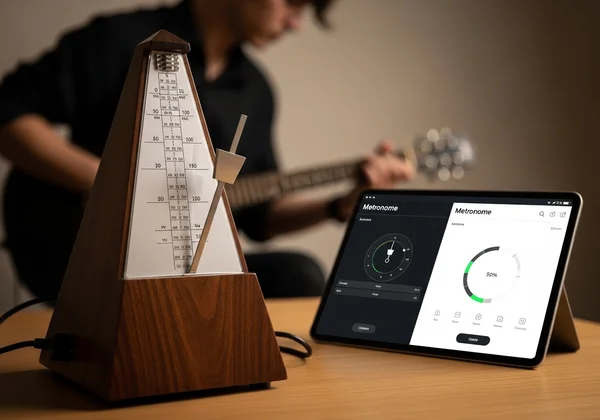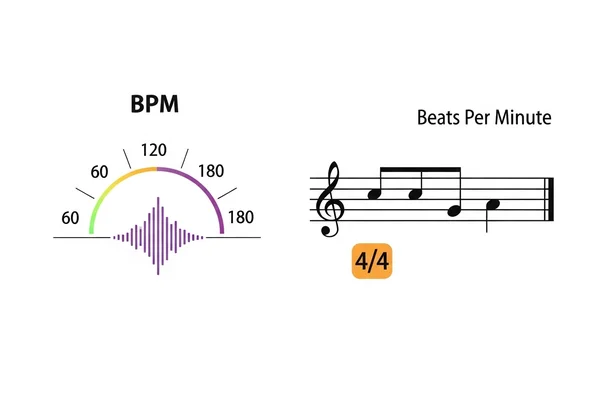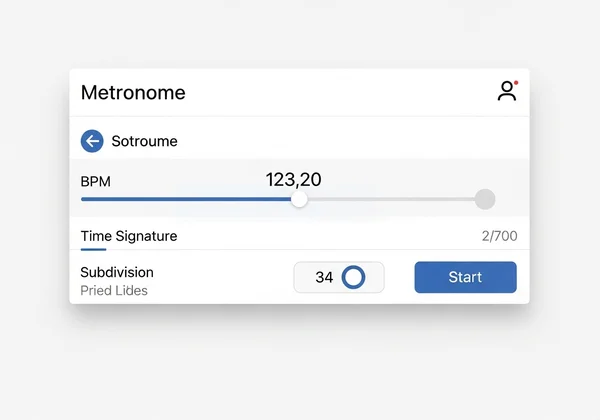Rhythm 101: Beginner's Guide to Using Your Online Metronome
Feeling lost with rhythm or struggling to keep time with your favorite songs? You're not alone! For any new musician, dancer, or creator, mastering a steady beat is the foundation of everything. This guide will demystify the metronome, revealing why it's your most important practice tool. We'll show you exactly how to use a metronome for beginners, with simple, actionable steps to boost your timing from day one. Discover the best metronome online experience and transform your practice with our powerful and free tool available right here at MetronomeOnline.org.
What is a Metronome & Why Every Beginner Needs One
At its core, a metronome is a device that produces a steady, consistent click or beep at a set speed. Think of it as an unwavering musical clock that never speeds up or slows down unless you tell it to. For anyone starting out, from guitar players to dancers, this consistent pulse is an invaluable guide. It replaces guesswork with precision, turning shaky timing into a rock-solid foundation.

The Essential Purpose of Your Rhythm Buddy: Beyond the Click
So, what a metronome does is simple yet profound: it provides an objective reference for time. Our internal sense of rhythm can be unreliable, especially when we're learning something new. We might unintentionally speed up during easy parts or slow down when things get tricky. A metronome acts as your honest practice partner, holding you accountable to the beat and helping you build an internal clock that you can rely on, even when the metronome is off. It's the key to developing a professional sense of timing and groove.
How a Metronome Improves Your Playing: Stability, Speed, and Confidence
Regular practice with a metronome delivers incredible benefits that will dramatically improve your playing or performance. First, it builds rhythmic stability. Your playing will sound tighter, more polished, and more cohesive, whether you're playing alone or with others. Second, it's the safest and most effective way to build speed. By gradually increasing the tempo, you can master challenging passages without sacrificing accuracy. Finally, it builds confidence. Knowing you can lock into any tempo gives you the freedom to focus on other aspects of your performance, like expression and dynamics.
Decoding the Basics: BPM, Time Signatures & Subdivisions Explained Simply
The interface of a metronome might seem technical at first, but the core concepts are straightforward. Understanding these three elements—BPM, time signatures, and subdivisions—is essential for any effective rhythm practice basics. Let's break them down into simple terms.
Understanding BPM: Your Speed Dial for Music Practice
Have you ever wondered what is BPM? It stands for "Beats Per Minute," and it's the standard way to measure tempo, or the speed of a piece of music. A BPM of 60 means there is one beat every second (60 beats in 60 seconds). A BPM of 120 means there are two beats every second. The slider or number input on an online metronome is your speed dial, allowing you to set the perfect pace for any exercise or song. It’s the fundamental setting you’ll use every time you practice.
Time Signatures Demystified: What Does 4/4 Time Mean?
A time signature tells you how many beats are in each measure of music. The most common one you'll encounter is 4/4, often called "common time." The question, what does 4/4 time mean, has a simple answer: it means there are four beats in every measure. The metronome will often provide a distinct sound on the first beat (the "downbeat") to help you keep track: ONE-two-three-four, ONE-two-three-four. Our free tool allows you to set various time signatures, so you can also practice waltzes (3/4 time) or marches (2/4 time) with ease.

Getting Groovy with Subdivisions: Adding Detail to Your Rhythm
While the main click keeps the beat, the real magic of rhythm happens between those clicks. Rhythm subdivisions are smaller rhythmic units that divide the main beat. For example, you can divide a quarter note beat (the main click) into two eighth notes ("1-and-2-and") or four sixteenth notes ("1-e-and-a-2-e-and-a"). Practicing with subdivisions helps you develop precision and play more complex, groovy rhythms that define genres like funk, rock, and jazz.
How to Use an Online Metronome Effectively
Now that you understand the basics, it's time to put them into practice. Using a metronome online is incredibly simple and is the first step toward mastering your rhythm. This is where your journey truly begins.
Getting Started with Your Online Metronome: A Quick Setup Guide
Using our free tool is designed to be intuitive. Here’s a quick setup guide to get you started in seconds:
-
Visit the Homepage: Go to MetronomeOnline.org. You’ll see the metronome interface, ready to go.
-
Set Your BPM: Use the slider or type in a number to set your desired tempo. For a beginner, starting around 60-80 BPM is a great choice.
-
Choose the Time Signature: For now, stick with 4/4. This is the "Beats per measure" setting.
-
Press Start: Hit the "Start" button and listen to the steady click. Focus on internalizing the pulse before you even pick up your instrument.

Your 7-Day Beginner Metronome Practice Plan: Build a Solid Foundation
Consistency is key. Follow this simple practice plan for just 5-10 minutes a day to build a strong rhythmic foundation.
- Day 1: Set the metronome to 70 BPM. Just clap your hands to the beat. Feel the pulse.
- Day 2: Play a single, comfortable note on your instrument with every click. Focus on perfect synchronization.
- Day 3: Practice a simple one-octave scale (like C Major) up and down, playing one note per click.
- Day 4: Increase the tempo to 80 BPM and repeat Day 3's exercise.
- Day 5: Set the metronome back to 70 BPM. This time, try playing two notes for every click (eighth notes). Count "1-and-2-and..."
- Day 6: Try playing a very simple song or riff you know along with the metronome.
- Day 7: Experiment! Use the tap tempo tool to find the BPM of your favorite song and try to play along.
Smart Practice Habits: Tips for Beginner Rhythm Improvement
Once you're comfortable with the basics, you can incorporate smarter habits to accelerate your progress. A metronome is more than just a clicker; it's a versatile rhythm practice tool that can be used in creative ways.
Finding Your Optimal Practice Tempo: What is a Good Tempo?
Many beginners ask, what is a good tempo for practice? The answer is simple: the speed at which you can play perfectly. The golden rule is to start slow—slower than you think you need. If you're making mistakes, you're going too fast. Find a practice tempo where your performance is clean and accurate, then gradually increase the BPM by 2-4 beats at a time. This slow, methodical approach builds muscle memory correctly and is the fastest way to achieve high-speed precision.
Using "Tap Tempo" to Match Any Beat or Song BPM
Ever wanted to know the exact speed of a song you're trying to learn? The tap tempo feature is your solution. Simply listen to the song and tap along to the beat on the "Tap BPM" button on our website. After a few taps, it will calculate the average BPM for you. This is an incredibly useful feature for learning cover songs or finding the right tempo for a new composition. You can try the BPM counter right now to see how easy it is.

Master Your Rhythm, Unlock Your Musical Potential
Rhythmic mastery is a journey, not a sprint, and your metronome is the most vital tool in your arsenal. Transform it from a simple click into your personal rhythm coach, building the discipline and precision that elevates your playing. Every session with a dedicated online metronome is an investment in your musical future, making practice effective and even fun.
Don't wait another day to start building a rock-solid rhythmic foundation. Head over to MetronomeOnline.org to use our powerful, free, and fully customizable metronome. Start with the 7-day plan, explore different tempos, and make that steady click your guide to unlocking your true potential.
Common Questions for Metronome Beginners
How do I find the BPM of a song using a metronome?
The easiest way is to use a tap tempo feature. Simply visit a site like MetronomeOnline.org, find the "Tap BPM" button, and tap your finger along with the beat of the song. The tool will automatically calculate and display the song's BPM for you.
What does 4/4 time mean in music and how do I count it?
What does 4/4 time mean is that there are four beats in each measure, and the quarter note gets one beat. You simply count steadily: "1, 2, 3, 4" for each measure, with the "1" being the strongest beat. This is the most common time signature in pop, rock, and country music.
What is a good starting tempo for metronome practice as a beginner?
A great starting tempo is between 60 and 80 BPM. This range is slow enough to allow you to think and execute cleanly without feeling rushed. The most important thing is to choose a speed where you can play without mistakes. You can always increase the speed later.
Can a metronome really improve my playing if I'm just starting out?
Absolutely. In fact, the beginning is the most critical time to use a metronome. It helps you build a strong internal sense of time from day one, preventing the formation of bad habits like rushing or dragging. Consistent practice with a metronome is one of the fastest ways to sound more polished and professional.